Intel to Launch Next-Gen Sapphire Rapids Xeon with High Bandwidth Memory
by Dr. Ian Cutress on June 28, 2021 12:00 PM EST- Posted in
- CPUs
- Intel
- Xeon
- HBM
- Xeon Scalable
- Sapphire Rapids
- SPR-HBM
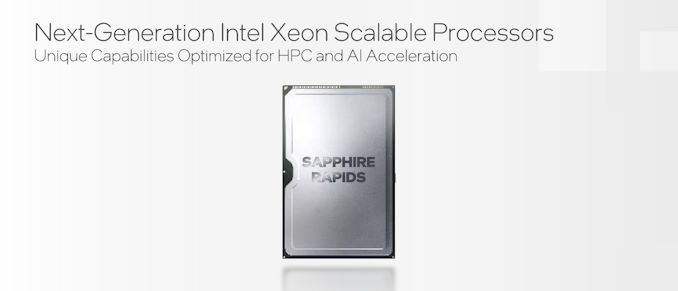
As part of today’s International Supercomputing 2021 (ISC) announcements, Intel is showcasing that it will be launching a version of its upcoming Sapphire Rapids (SPR) Xeon Scalable processor with high-bandwidth memory (HBM). This version of SPR-HBM will come later in 2022, after the main launch of Sapphire Rapids, and Intel has stated that it will be part of its general availability offering to all, rather than a vendor-specific implementation.
Hitting a Memory Bandwidth Limit
As core counts have increased in the server processor space, the designers of these processors have to ensure that there is enough data for the cores to enable peak performance. This means developing large fast caches per core so enough data is close by at high speed, there are high bandwidth interconnects inside the processor to shuttle data around, and there is enough main memory bandwidth from data stores located off the processor.
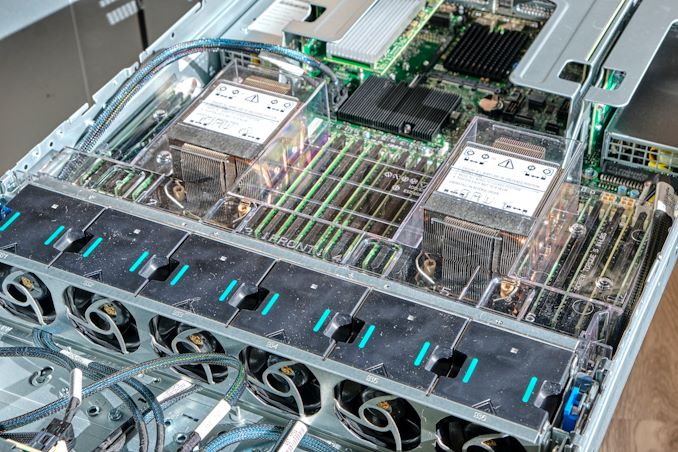
Our Ice Lake Xeon Review system with 32 DDR4-3200 Slots
Here at AnandTech, we have been asking processor vendors about this last point, about main memory, for a while. There is only so much bandwidth that can be achieved by continually adding DDR4 (and soon to be DDR5) memory channels. Current eight-channel DDR4-3200 memory designs, for example, have a theoretical maximum of 204.8 gigabytes per second, which pales in comparison to GPUs which quote 1000 gigabytes per second or more. GPUs are able to achieve higher bandwidths because they use GDDR, soldered onto the board, which allows for tighter tolerances at the expense of a modular design. Very few main processors for servers have ever had main memory be integrated at such a level.
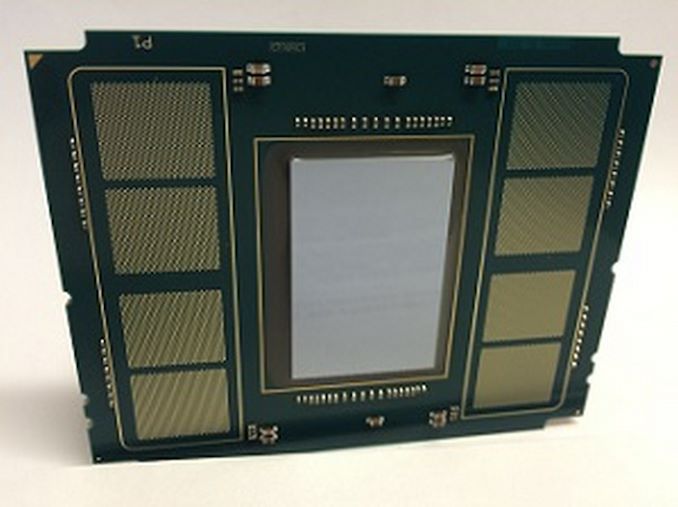
Intel Xeon Phi 'KNL' with 8 MCDRAM Pads in 2015
One of the processors that used to be built with integrated memory was Intel’s Xeon Phi, a product discontinued a couple of years ago. The basis of the Xeon Phi design was lots of vector compute, controlled by up to 72 basic cores, but paired with 8-16 GB of on-board ‘MCDRAM’, connected via 4-8 on-board chiplets in the package. This allowed for 400 gigabytes per second of cache or addressable memory, paired with 384 GB of main memory at 102 gigabytes per second. However, since Xeon Phi was discontinued, no main server processor (at least for x86) announced to the public has had this sort of configuration.
New Sapphire Rapids with High-Bandwidth Memory
Until next year, that is. Intel’s new Sapphire Rapids Xeon Scalable with High-Bandwidth Memory (SPR-HBM) will be coming to market. Rather than hide it away for use with one particular hyperscaler, Intel has stated to AnandTech that they are committed to making HBM-enabled Sapphire Rapids available to all enterprise customers and server vendors as well. These versions will come out after the main Sapphire Rapids launch, and entertain some interesting configurations. We understand that this means SPR-HBM will be available in a socketed configuration.
Intel states that SPR-HBM can be used with standard DDR5, offering an additional tier in memory caching. The HBM can be addressed directly or left as an automatic cache we understand, which would be very similar to how Intel's Xeon Phi processors could access their high bandwidth memory.
Alternatively, SPR-HBM can work without any DDR5 at all. This reduces the physical footprint of the processor, allowing for a denser design in compute-dense servers that do not rely much on memory capacity (these customers were already asking for quad-channel design optimizations anyway).
The amount of memory was not disclosed, nor the bandwidth or the technology. At the very least, we expect the equivalent of up to 8-Hi stacks of HBM2e, up to 16GB each, with 1-4 stacks onboard leading to 64 GB of HBM. At a theoretical top speed of 460 GB/s per stack, this would mean 1840 GB/s of bandwidth, although we can imagine something more akin to 1 TB/s for yield and power which would still give a sizeable uplift. Depending on demand, Intel may fill out different versions of the memory into different processor options.
One of the key elements to consider here is that on-package memory will have an associated power cost within the package. So for every watt that the HBM requires inside the package, that is one less watt for computational performance on the CPU cores. That being said, server processors often do not push the boundaries on peak frequencies, instead opting for a more efficient power/frequency point and scaling the cores. However HBM in this regard is a tradeoff - if HBM were to take 10-20W per stack, four stacks would easily eat into the power budget for the processor (and that power budget has to be managed with additional controllers and power delivery, adding complexity and cost).
One thing that was confusing about Intel’s presentation, and I asked about this but my question was ignored during the virtual briefing, is that Intel keeps putting out different package images of Sapphire Rapids. In the briefing deck for this announcement, there was already two variants. The one above (which actually looks like an elongated Xe-HP package that someone put a logo on) and this one (which is more square and has different notches):
There have been some unconfirmed leaks online showcasing SPR in a third different package, making it all confusing.
Sapphire Rapids: What We Know
Intel has been teasing Sapphire Rapids for almost two years as the successor to its Ice Lake Xeon Scalable family of processors. Built on 10nm Enhanced SuperFin, SPR will be Intel’s first processors to use DDR5 memory, have PCIe 5 connectivity, and support CXL 1.1 for next-generation connections. Also on memory, Intel has stated that Sapphire Rapids will support Crow Pass, the next generation of Intel Optane memory.
For core technology, Intel (re)confirmed that Sapphire Rapids will be using Golden Cove cores as part of its design. Golden Cove will be central to Intel's Alder Lake consumer processor later this year, however Intel was quick to point out that Sapphire Rapids will offer a ‘server-optimized’ configuration of the core. Intel has done this in the past with both its Skylake Xeon and Ice Lake Xeon processors wherein the server variant often has a different L2/L3 cache structure than the consumer processors, as well as a different interconnect (ring vs mesh, mesh on servers).
Sapphire Rapids will be the core processor at the heart of the Aurora supercomputer at Argonne National Labs, where two SPR processors will be paired with six Intel Ponte Vecchio accelerators, which will also be new to the market. Today's announcement confirms that Aurora will be using the SPR-HBM version of Sapphire Rapids.
As part of this announcement today, Intel also stated that Ponte Vecchio will be widely available, in OAM and 4x dense form factors:
Sapphire Rapids will also be the first Intel processors to support Advanced Matrix Extensions (AMX), which we understand to help accelerate matrix heavy workflows such as machine learning alongside also having BFloat16 support. This will be paired with updates to Intel’s DL Boost software and OneAPI support. As Intel processors are still very popular for machine learning, especially training, Intel wants to capitalize on any future growth in this market with Sapphire Rapids. SPR will also be updated with Intel’s latest hardware based security.
It is highly anticipated that Sapphire Rapids will also be Intel’s first multi compute-die Xeon where the silicon is designed to be integrated (we’re not counting Cascade Lake-AP Hybrids), and there are unconfirmed leaks to suggest this is the case, however nothing that Intel has yet verified.
The Aurora supercomputer is expected to be delivered by the end of 2021, and is anticipated to not only be the first official deployment of Sapphire Rapids, but also SPR-HBM. We expect a full launch of the platform sometime in the first half of 2022, with general availability soon after. The exact launch of SPR-HBM beyond HPC workloads is unknown, however given those time frames, Q4 2022 seems fairly reasonable depending on how aggressive Intel wants to attack the launch in light of any competition from other x86 vendors or Arm vendors. Even with SPR-HBM being offered to everyone, Intel may decide to prioritize key HPC customers over general availability.
Related Reading
- SuperComputing 15: Intel’s Knights Landing / Xeon Phi Silicon on Display
- A Few Notes on Intel’s Knights Landing and MCDRAM Modes from SC15
- Intel Announces Knights Mill: A Xeon Phi For Deep Learning
- Intel Begins EOL Plan for Xeon Phi 7200-Series ‘Knights Landing’ Host Processors
- Knights Mill Spotted at Supercomputing
- The Larrabee Chapter Closes: Intel's Final Xeon Phi Processors Now in EOL
- Intel’s 2021 Exascale Vision in Aurora: Two Sapphire Rapids CPUs with Six Ponte Vecchio GPUs
- Intel’s Xeon & Xe Compute Accelerators to Power Aurora Exascale Supercomputer
- Hot Chips 33 (2021) Schedule Announced: Alder Lake, IBM Z, Sapphire Rapids, Ponte Vecchio
- Intel’s Full Enterprise Portfolio: An Interview with VP of Xeon, Lisa Spelman
- What Products Use Intel 10nm? SuperFin and 10++ Demystified
- Intel 3rd Gen Xeon Scalable (Ice Lake SP) Review: Generationally Big, Competitively Small


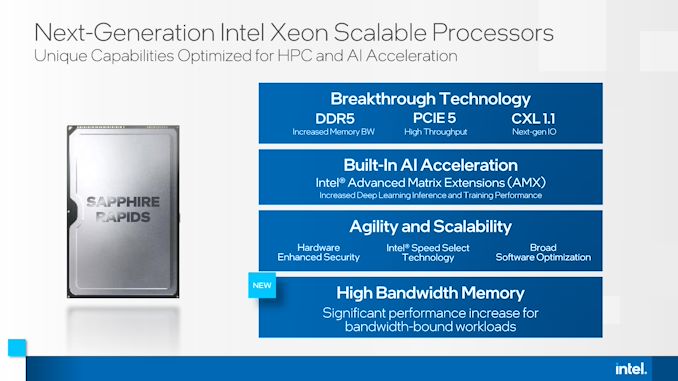
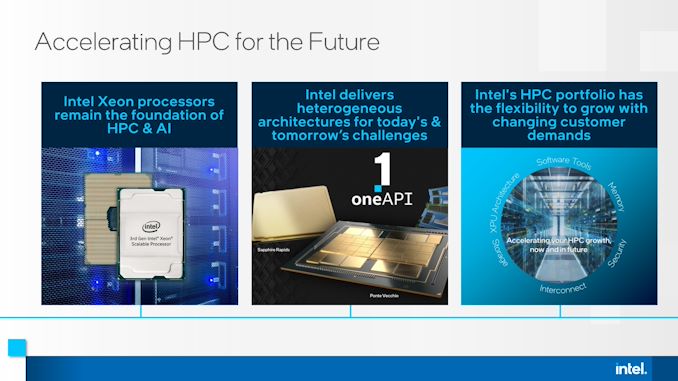

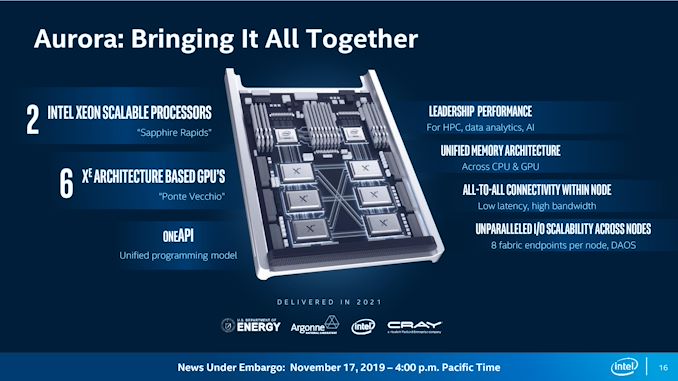








149 Comments
View All Comments
mode_13h - Wednesday, July 7, 2021 - link
> GPUs designed for mining as if they’re PC gaming parts.I don't agree with this, at all. As Nvidia has recently demonstrated, it's actually *hard* to make a GPU that's bad at mining!
Oxford Guy - Thursday, July 8, 2021 - link
‘I don't agree with this, at all.’I’m completely shocked.
Meanwhile, when Nvidia was selling Maxwell at reduced pricing (versus its appetite for extreme pricing) because GCN cards were more targeted toward mining, the company responded by achieving mining attractiveness parity with AMD.
But the company really wants to only sell the cards to gamers. Ha.
Meanwhile, AMD isn’t even feeling it’s worth the bother to try to feign disinterest in maximizing its profits via mining.
mode_13h - Wednesday, July 7, 2021 - link
> Typing on this phoneMy sympathies. I do enjoy the irony of a pc master-race post being typed on a phone, though. Thanks for that.
Oxford Guy - Thursday, July 8, 2021 - link
‘I do enjoy the irony of a pc master-race post being typed on a phone, though. Thanks for that.’Evidently more than reading posts for comprehension.
mode_13h - Thursday, July 8, 2021 - link
> Evidently more than reading posts for comprehension.Your sensitivity to "ad hom" is dialed up to 11, but you seem to throw shade on the slightest whim. Something's wrong with that.
Trust that if I respond to a post, I've read it enough times to believe I understand it (unless I ask about something not clear to me). If I miss something in your intent or meaning, there are numerous other explanations. And rather than speculate why I missed something, you need only point out when I do, so we can continue.
Qasar - Tuesday, July 6, 2021 - link
" I have written extensively wherein the irrefutable elementary logic of the situation has been explained. " " I have posted extensively about the scam and the nature of it. " and i dont recall AT ALL you posting ANY links to this BS claim. all i have seen is personal options of this BS claim, oxford guy, post some links or admit is just your opinion. the FACT that mode 13 asked you for proof, and ALL you did was ramble, and post no links, at this time, proves it is just your opinion.instead of posting ramble, post links, this way some of us, can also see where you are geting this BS from.
GeoffreyA - Tuesday, July 6, 2021 - link
Oxford Guy, I can't stand consoles myself, but if I may venture my opinion, I'd say people like consoles because one just puts a game in, presses a button, and plays, whereas PCs take a lot more work (supposedly). Sony and MS churn out consoles to make money; AMD saw an opportunity for business and didn't waste time. As a side effect of that, PC gaming has taken some knocks. It's more a symptom of the mess, not the motive. Also, consoles have been in homes for decades, even the old TV games with those cartridges.Oxford Guy - Wednesday, July 7, 2021 - link
There is nothing about the ‘console’ since Jaguar that offers anything other than a duplicate parasitic walled software garden.Every feature except for the specific DRM is available on the PC. That’s because the ‘consoles’ are PCs.
The faux convenience people always cite is nothing more than DRM. The bygone days where consoles were unique and offered actual advantages have been over since the Jaguar machines. Everything is standard hardware. And if convenience were really the motivation of the ‘console’ designers they wouldn’t be selling them with the same junk joystick mechanism (drift) and all optical media would have been put inside a protective shell (e.g. DVD-RAM).
As someone who saw what actual consoles were since the 70s, the breathtaking passivity of the more modern ‘console’ consumer (unprotected high-density optical media, for machines used by kids) was something. Now, though, even though there is 0% substantive hardware difference to justify the claims about convenience and everything else involved in claiming these DRM vehicles add value for the consumer — people continue to recycle the same archaic points. Back when a console had cartridges and a power button (and computer joysticks were inferior to console digital pads) the convenience argument held some water. More importantly was the fact that the hardware had to be much different due to high cost for PC-level equipment. (Has not been true since Jaguar.)
It’s impossible to credibly argue that evolution that resulted in a 100% identical x86 common hardware platform simultaneously justifies a bunch of duplicate DRM gardens. The ‘exclusive’ releases don’t add one iota of value, considering the costs.
mode_13h - Wednesday, July 7, 2021 - link
> There is nothing about the ‘console’ since Jaguar that offers anythingPS3 offered blu-ray playback and the Cell CPU was genuinely faster than any PC CPU of its day (hard to *use* that power, but its raw compute power was off the charts). Add to that bluetooth controllers that had farther range than anything for the PC.
> all optical media would have been put inside a protective shell (e.g. DVD-RAM).
PCs stopped doing that even before consoles adopted optical media!
> even though there is 0% substantive hardware difference to justify the claims about convenience
It is more convenient, since it's better assembled. And it's also cheaper for the horsepower you get.
> The faux convenience people always cite is nothing more than DRM.
That's not true. People can buy a console game knowing it'll work exactly the same on their console as everybody else's, including the reviewers who might've motivated them to buy it.
As for DRM, you act as if that doesn't exist on the PC.
Oxford Guy - Thursday, July 8, 2021 - link
Okay. I’ll respond to this post first. The only substantive point you made is praise for the PS3, which is not x86 and is therefore more irrelevant than not.You even quoted me saying ‘Jaguar’ but didn’t seem to read carefully enough to know what to try to rebut.
Your other claims, like build quality, are total nonsense. The only thing special about the ‘consoles’ is their particular DRM. That’s it. That makes all the claims about specialness unfounded in fact. They are PCs being peddled as items captured by special DRM, DRM that is parasitic for consumers.